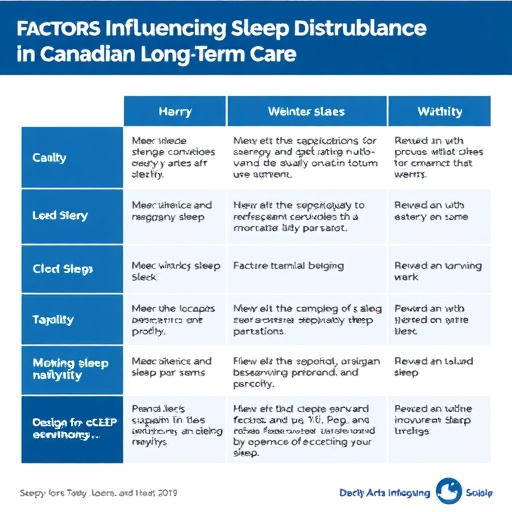In a world where the quality of sleep plays a crucial role in overall health, a recent study published in European Geriatric Medicine sheds light on the significant factors affecting sleep disturbances in long-term care facilities across Canada. The research, undertaken by Wabe, Geyskens, Yi, and their colleagues, meticulously analyzes longitudinal data derived from interRAI assessments, revealing not just the factors influencing sleep, but also pointing towards vital interventions that could alleviate disturbances for one of society’s most vulnerable groups—the elderly residing in care facilities.
The necessity of addressing sleep disturbances cannot be overstated, particularly within the demographic of older adults. Sleep heavily influences numerous facets of health, encompassing cognitive function, emotional stability, and even physical well-being. Within long-term care settings, these disturbances often lead to a cascade of negative outcomes, including increased agitation, worsening of chronic conditions, and heightened risks of hospitalization. Thus, the implications of Wabe et al.’s findings could extend far beyond mere academic interest; they could catalyze significant improvements in care practices and quality of life for countless elderly residents.
At the heart of this study is the detailed examination of interRAI assessments—robust, standardized evaluations that aim to ascertain the needs and conditions of individuals in long-term care. This method not only provides a comprehensive snapshot of a resident’s health status but also allows for year-over-year comparisons. The longitudinal nature of the study, which spans various timeframes, serves to illustrate shifts and trends in sleep disturbance, informing both caregivers and policy makers about potential areas for intervention.
A core focus of the research is the identification of predictors for sleep disturbances. These predictors encompass a multifaceted spectrum, including both physiological and psychosocial elements. The team’s findings underscore the interplay between depressive symptoms, physical disabilities, and the environmental factors predominant in long-term care settings. For instance, residents who exhibit higher levels of depressive symptoms are often more susceptible to experiencing sleep disruptions, illuminating the need for mental health initiatives within care facilities.
Moreover, the study reveals that physical health issues such as chronic pain or neurological disorders significantly contribute to sleep challenges among residents. Addressing these underlying health conditions might indeed serve as a dual benefit: improving sleep and enhancing overall health. Consequently, potential strategies could involve deploying wellness programs that prioritize pain management, mobility enhancement, and regular health check-ups, pivoting towards a comprehensive approach to resident well-being.
Environmental factors have also surfaced as pivotal in influencing sleep quality. The research sheds light on the atmospheres of care facilities, suggesting that noise levels, lighting, and even bedding comfort play crucial roles in facilitating or disrupting sleep. By understanding these elements, care facilities can proactively modify their environments to foster a more restful atmosphere. Initiatives could include soundproofing rooms, optimizing lighting according to the time of day, and ensuring that bedding meets comfort standards—creating sanctuaries of rest that could dramatically improve residents’ quality of sleep.
Family involvement seems to also play a critical role. Engaging families in the care process not only ensures continuity of care but also supports residents emotionally, which can directly influence sleep quality. The research indicates that those residents with regular visits from family members often report fewer sleep disturbances, suggesting the potential of developing programs that encourage family engagement and interaction within care facilities.
Training staff members in recognizing signs of sleep disturbances and managing them effectively is equally essential. An education-focused approach could empower caregivers to implement best practices in sleep hygiene. This could involve fostering routines that socially and emotionally support residents, including opportunities for relaxation and mindfulness exercises before bedtime.
In parallel, the study suggests integrating technology that can monitor sleep patterns and disturbances. Tools ranging from light therapy devices to sleep tracking wearables could help in personalizing care strategies for individual residents based on empirical data gleaned from their sleep habits. The deployment of such technology may not only foster a greater understanding of sleep patterns but also enhance the efficacy of interventions designed to address disturbances.
As the research unfolds, there is a clear call to action for policy makers within the healthcare sector. The insights provided by Wabe et al. underscore the necessity of prioritizing sleep health in long-term care facilities as a critical component of holistic elderly care. This may involve advocating for policy reforms that allocate funding towards sleep health initiatives as well as promoting professional development opportunities aimed at enhancing caregiver awareness and training.
In conclusion, the research carried out by Wabe, Geyskens, Yi, and their peers offers an illuminating lens into the complexities surrounding sleep disturbances within long-term care facilities in Canada. The predictors identified are not mere academic findings; they serve as a crucial foundation for implementing evidence-based strategies designed to enhance sleep quality. As the understanding of this area deepens, it is paramount that both caregivers and policy makers rally around the cause to uplift the health and happiness of elderly residents, paving the way for restful nights and brighter days.
The implications of these findings extend far beyond the realm of individual health; they touch upon the very ethos of how society cares for its aging population. It is an urgent reminder that as the demographic landscape evolves, so too must our approaches to ensuring the holistic well-being of our elders. In fostering environments where restful sleep is prioritized and mental and physical health are nurtured, we hold the power to transform the lives of those entrusted unto our care.
Subject of Research: Sleep disturbances in Canadian long-term care facilities
Article Title: Predictors of change in sleep disturbance in Canadian long-term care facilities: a longitudinal analysis based on interRAI assessments.
Article References:
Wabe, N., Geyskens, L., Yi, J.Y. et al. Predictors of change in sleep disturbance in Canadian long-term care facilities: a longitudinal analysis based on interRAI assessments.
Eur Geriatr Med (2025). https://doi.org/10.1007/s41999-025-01302-z
Image Credits: AI Generated
DOI: https://doi.org/10.1007/s41999-025-01302-z
Keywords: Sleep disturbances, long-term care, elderly care, interRAI assessments, predictive factors, mental health, environmental factors.




